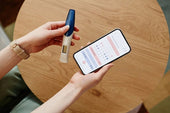How to Track Ovulation With Irregular Periods: Empowering Your Fertility Journey

Irregular menstrual cycles can make fertility tracking feel like navigating without a compass. When you have an erratic cycle, pinpointing the ovulatory window can seem daunting, especially if you’ve been trying to conceive or are simply seeking clarity about your reproductive health. Understanding how to track ovulation with irregular periods—including the biological mechanisms underlying ovulation, the factors influencing the menstrual cycle, and the methods that can help you identify fertile days—is crucial for improving your chances of achieving pregnancy or becoming more in tune with your body’s rhythms.
This article will dive deep into the intricacies of ovulation, explore the latest findings on lifestyle factors that impact reproductive health, discuss practical strategies for monitoring fertility, and highlight when professional guidance might be beneficial. By the end, you’ll be better equipped with evidence-based tools and insights to confidently manage unpredictability in your cycle without repeating information or leaving essential details overlooked.
Unraveling the Menstrual Cycle
A typical menstrual cycle spans roughly 21 to 35 days, with ovulation occurring once per cycle when the ovary releases a mature egg. This event usually transpires around the midpoint of the cycle, but individuals with predictable 28-day cycles might ovulate around day 14. Those with unpredictable or widely fluctuating cycles often find themselves wondering, if I have irregular periods when do I ovulate? The exact timing can vary from one month to the next, causing confusion and making common ovulation prediction methods more challenging. Yet, having a thorough grasp of how hormonal interplay shapes the menstrual cycle can be invaluable for discovering personal patterns, even when those patterns deviate from the norm [1].
At the start of each cycle, the body’s levels of follicle-stimulating hormone (FSH) rise, signaling follicles within the ovaries to mature. One follicle typically dominates, producing estrogen, which helps thicken the uterine lining. Once estrogen peaks, the pituitary gland releases luteinizing hormone (LH), triggering ovulation. After ovulation, the ruptured follicle becomes the corpus luteum and secretes progesterone. This hormone maintains the uterine lining and prepares it for potential implantation. If fertilization doesn’t happen, progesterone and estrogen drop, leading to shedding of the uterine lining during menstruation.
Distinctive Signs of Ovulation
When cycles are stable, observing signs like changes in cervical mucus or shifts in basal body temperature can help identify the fertile window. But those with erratic patterns frequently ask, irregular cycle when do I ovulate? The good news is that the body still presents indications of fertility, albeit less predictably. Prior to ovulation, cervical mucus typically transforms from thick and cloudy to more abundant, slick, and clear. An egg-white consistency often suggests rising estrogen, hinting that ovulation may be approaching [2].
Basal body temperature (BBT) tracking can offer an additional layer of insight. By measuring your temperature every morning upon waking, you might notice a slight surge—generally about 0.5°F or 0.3°C—immediately after ovulation. While this post-ovulatory shift can confirm that ovulation has already occurred, it doesn’t provide a heads-up before ovulation happens. As a result, combining BBT with other indicators, like hormone test kits, can increase the accuracy of any predictions you make.
Some individuals experience mittelschmerz, a mild pelvic discomfort on one side of the abdomen. Though not everyone notices it, this pain can coincide with ovulation and indicate which ovary released the egg. While such signs are helpful, they can be inconsistent if your cycle is frequently off schedule.
Innovative Techniques for Pinpointing Fertility
Advancements in technology have led to various tools and apps designed to help you track fertility indicators more efficiently. Wearable devices can monitor skin temperature and heart rate variability, offering clues about physiological shifts that coincide with ovulation. These gadgets can be particularly beneficial for those concerned about how to track ovulation irregular period and individuals who have unpredictable cycles due to lifestyle or health factors.
Ovulation prediction kits (OPKs) detect the surge in luteinizing hormone through urine tests. For people with inconsistent cycles, starting these tests soon after menstruation ends can help catch the LH surge. However, if you’re grappling with the issue of “when will I ovulate if my period is irregular,” you may need to test over more days than someone with predictable menstruation to accurately catch that spike. Hormone-monitoring saliva microscopes can also be employed, which examine ferning patterns related to estrogen fluctuations, though these devices may require some practice to interpret [3].
Another approach involves ultrasound monitoring, typically done under a healthcare provider’s guidance. Regular ultrasounds can measure the size of ovarian follicles, indicating their readiness to release an egg. While ultrasound is highly accurate, it might be costly or time-intensive and is often reserved for those facing significant challenges conceiving or undergoing fertility treatments. Nonetheless, for individuals who’ve tried more accessible methods and still feel unsure about how to determine ovulation with irregular periods, professional imaging can be enlightening.
If you're interested in learning more about pinpointing your fertile window, you may want to explore our guide on how do you track ovulation and find the best time to conceive.
Creating a Personalized Tracking System
Developing a cohesive strategy can simplify the seemingly complex endeavor of how to track ovulation when periods are irregular?. First, choose at least two fertility signs to monitor, such as cervical mucus changes and BBT, or combine OPKs with daily assessments of your cervix’s position and texture. Record these observations in a journal or use a mobile application designed to chart fertility metrics. This combined method allows you to cross-verify data, catching patterns that might be missed if you focus on only one sign.
Staying consistent is vital. Aim to check your basal temperature at the same time each morning, preferably after a full night’s rest. Note any factors—like late-night activities or illness—that could disrupt readings. If you detect a pattern across multiple cycles, you may be able to plan intercourse or fertility treatments more effectively. Even those pondering questions like irregular periods when will I ovulate? often discover that consistency in tracking can help them spot subtle shifts in hormone levels or bodily signs [4].
Using Online Resources Wisely
Access to online platforms has expanded the range of tools for individuals trying to predict their most fertile days. A variety of websites and mobile apps can aggregate data from ovulation kits, temperature logs, and symptom diaries into easy-to-read charts. These platforms may incorporate algorithms to offer approximate fertility windows, although the accuracy might not be identical for every user. Some ask questions like, “Are you feeling more energized or moody?” or “How is your cervical fluid today?” to refine the prediction. This feature can be particularly useful for people grappling with “predicting ovulation irregular cycle” scenarios.
Tools that attempt to combine irregular cycle data and pregnancy projections also exist. For instance, an irregular periods and pregnancy calculator might analyze your historical cycles, any noted symptoms, and ovulation kit results to provide an estimated fertility window. While such calculators aren’t foolproof, they can guide your self-awareness and planning. Bear in mind that these platforms rely on average data sets, so they may not precisely reflect your unique hormone levels or follicular development. Nonetheless, they often serve as a foundational resource when establishing a personal fertility journal.
If you’re eager to simplify your cycle monitoring further, consider checking out our comprehensive guide on how to track period for additional insights into managing menstrual patterns.
Healthful Habits to Promote Hormonal Balance
Daily practices can influence ovulation timing. Consuming nutrient-dense meals that incorporate whole grains, lean proteins, fruits, and vegetables can support hormone regulation. Ensuring adequate intake of essential vitamins and minerals, particularly folic acid and iron, is often advised for anyone attempting to conceive or regulate their cycles. Moderation in caffeine and alcohol intake may further help stabilize hormonal rhythms, reducing the chances of ovulatory disruptions.
Physical activity is another factor that plays a crucial role in the menstrual cycle. Moderate exercise, such as brisk walking, yoga, or cycling, promotes circulatory health without causing the elevated cortisol levels sometimes linked to excessive workouts. Individuals anxious about im irregular when do I ovulate? might find that gentle exercise routines and stress-reduction strategies—like meditation, journaling, or deep breathing—improve overall cycle predictability [5].
When Medical Advice is Crucial
While do-it-yourself approaches can be beneficial, some circumstances call for professional evaluation. Individuals who have tried multiple strategies but still feel unsure about irregular periods when do I ovulate? might benefit from consulting an obstetrician-gynecologist or reproductive endocrinologist. Medical experts can run tests to diagnose underlying hormonal imbalances or reproductive conditions. In some instances, medication such as clomiphene citrate or letrozole is prescribed to stimulate ovulation. If fertility remains elusive, advanced reproductive therapies like in vitro fertilization (IVF) might be suggested.
The Bottom Line
How to track ovulation with irregular periods may appear complicated, but persistence, careful observation, and a willingness to explore various methods are powerful tools. If you’ve been wondering, “how to track ovulation with irregular periods?” or have questions like “How to track ovulation when periods are irregular?” you’re not alone. Many have discovered that a combination of daily temperature checks, cervical mucus evaluation, and hormone test kits can yield a clearer picture of when eggs are most likely to be released. Whether you’re seeking reassurance, planning for a family, or aiming to better understand the rhythms of your body, each of these strategies can help you gauge the timing of ovulation more accurately.
References
- Thiyagarajan DK, Basit H, Jeanmonod R. Physiology, Menstrual Cycle. [Updated 2024 Sep 27]. In: StatPearls [Internet]. Treasure Island (FL): StatPearls Publishing; 2025 Jan-. Available from: https://www.ncbi.nlm.nih.gov/books/NBK500020/
- Owen M. Physiological signs of ovulation and fertility readily observable by women. Linacre Q. 2013 Feb;80(1):17-23. doi: 10.1179/0024363912Z.0000000005. PMID: 24845657; PMCID: PMC6081768.
- Yeh PT, Kennedy CE, Van der Poel S, Matsaseng T, Bernard L, Narasimhan M. Should home-based ovulation predictor kits be offered as an additional approach for fertility management for women and couples desiring pregnancy? A systematic review and meta-analysis. BMJ Glob Health. 2019 Apr 25;4(2):e001403. doi: 10.1136/bmjgh-2019-001403. PMID: 31139458; PMCID: PMC6509595.
- Moghissi KS. Accuracy of basal body temperature for ovulation detection. Fertil Steril. 1976 Dec;27(12):1415-21. PMID: 1001528.
- Segarra I, Menárguez M, Roqué MV. Women's health, hormonal balance, and personal autonomy. Front Med (Lausanne). 2023 Jun 30;10:1167504. doi: 10.3389/fmed.2023.1167504. PMID: 37457571; PMCID: PMC10347535.





















